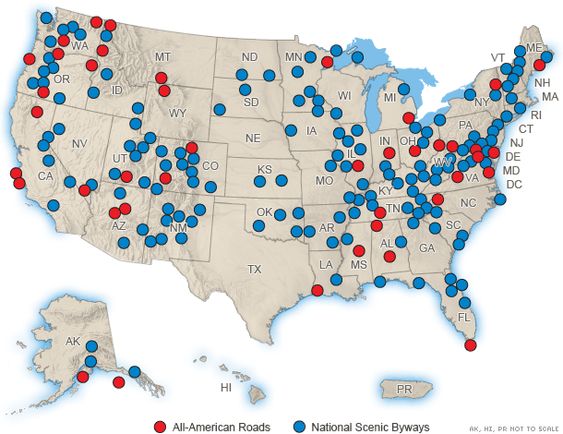National and State Highway Beautification Acts
According to the U.S. Department of Transportation and Federal Highways Administration “to be designated a National Scenic Byway, a road must possess characteristics of regional significance within at least one of the intrinsic qualities. All-American Roads must possess characteristics of national significance in at least two of the intrinsic qualities.”
It is unfortunate that Texas is quite literally not on the national byways map simply because, at the state level, we have failed to avail ourselves of promotional opportunities and dollars to tout travel on our scenic byways.

The National Scenic Byways Program is a voluntary, community-based program administered through the Federal Highway Administration to recognize, protect, and promote America’s most outstanding roads. The program identifies valuable archeological, cultural, historic, natural, recreational, and scenic byways, and it is a resource for travelers planning trips by car, bike, RV, and walking. However, until the Texas legislature authorizes a Texas Scenic Byways Program, we are literally off the map and are locked out of taking advantage of the national program. We are leaving federal dollars untapped. Although funding is not the biggest loss for Texas. Being “off-the-map” equates to lost opportunities for local communities and rural businesses to promote the unique character of Texas’ small towns and the beauty of our wide open spaces. Indeed it is a larger loss than the dollars to shore up a tourism industry working hard to rebound.
Texas can reap direct economic benefit from tourism spending in the byway regions, such as increases in sales, wages, salaries, and supplies, a fiscal boost that has been measured in other states. Additional business activity flows from this initial spending down the supply chain, increasing demand for supplies, creating jobs, and stimulating economic activity in their downstream industries.
For example, a University of Minnesota School of Business found that the state’s Paul Bunyan Scenic Byway generated nearly $22 million in visitor spending annually. A study of the Blue Ridge Parkway in North Carolina and Virginia, concluded that visitors spent $1.8 billion in counties adjacent to the parkway, resulting in $147 million in tax revenues and the creation of over 74,000 jobs. The Colorado Department of Transportation reported cumulated impact of Colorado byways on the state economy over a five-year period, including both direct visitor spending and indirect impacts in wage earnings, of $4.8 billion. For 2014 alone, Colorado byways generated $835 million in economic output (total spending) and $141 million in wage earnings for more than 4,000 jobs, or about $35,250 per employee.
We have an opportunity to raise visibility and awareness for our scenic byways and reach a nationwide audience. It is as simple as saying we want to tap into the deep reservoir of our proud Texas heritage and encourage travelers to experience our own “roads less traveled.” Taking what is commonly known as the back roads to explore small towns and natural areas is one of the best ways to invite tourists and our own future generations of Texans to enjoy the hospitality and history of the Lone Star State.
In Texas, we do have some protected highways that Scenic Texas has worked with the Texas Legislature over many sessions to protect. While these are not considered “Scenic Highways,” they are protected from new signage/billboards.
